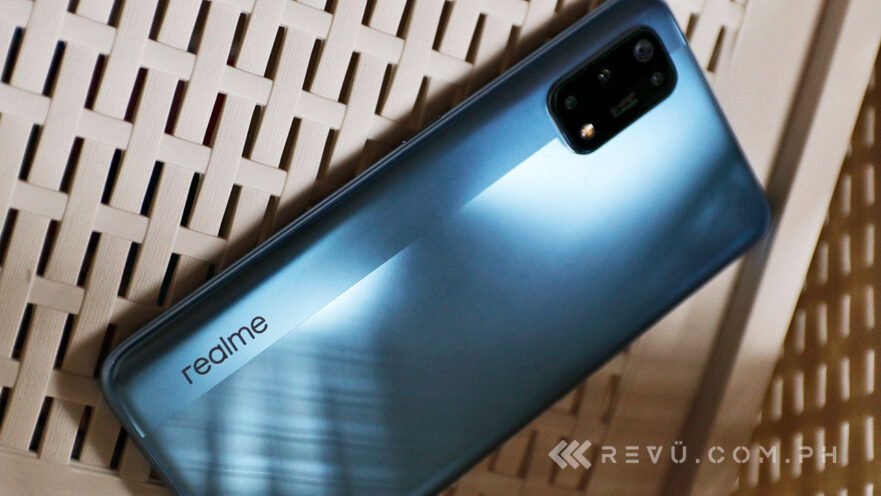Realme has been steadily expanding its portfolio in the Philippines. The fastest-growing smartphone vendor in the country recently launched the C12 and C15 locally. And now it follows those up with the Realme 7 series. The subject of this review is the “Pro” variant of a lineup that promises to “capture sharper and charge faster/fastest.”
The Realme 7 Pro is poised to be a capable smartphone for photography that charges extremely fast. But is that all this new device offers? With a higher price tag than the usual Realme handset, we expect it to be a good all-rounder. Will the Realme 7 Pro deliver? That’s what we hope to answer in this review.
Price and availability
Realme will only offer the 8GB RAM + 128GB storage configuration in the Philippines, and for P17,990 (around $371). Available in Mirror Silver and Mirror Blue colors, it will be sold at Realme stores and kiosks starting today, September 30. Until October 4, you will get a free automatic umbrella and Realme Band worth P2,390 ($49). The first 10 buyers of the phone at participating branches will also get a free pair of Realme Buds Q worth P1,490 ($31).
SEE ALSO: Realme 7 Pro, Realme 7, Realme Buds Q launched in PH
Realme is also offering Home Credit 0% installment plans at six or nine months. If you’re going to use your credit card to pay for the Realme 7 Pro, you can get 0% interest for six or 12 months from major banks at participating stores nationwide.
If you’d prefer to buy the new phone online, Lazada has also started selling the Realme 7 Pro at 1 pm today. The first 200 buyers will get a pair of Realme Buds Q for free.
Hardware
Realme brings its AG Split Design into the Realme 7 series, a departure from the handset that came before it. The company takes a sleeker, cleaner approach with the Realme 7 Pro having a shinier, two-tone finish that isn’t susceptible to having fingerprints stick on it. We miss the previous generation’s lightning pattern, and this more aesthetic-focused approach may or may not appeal to more consumers.
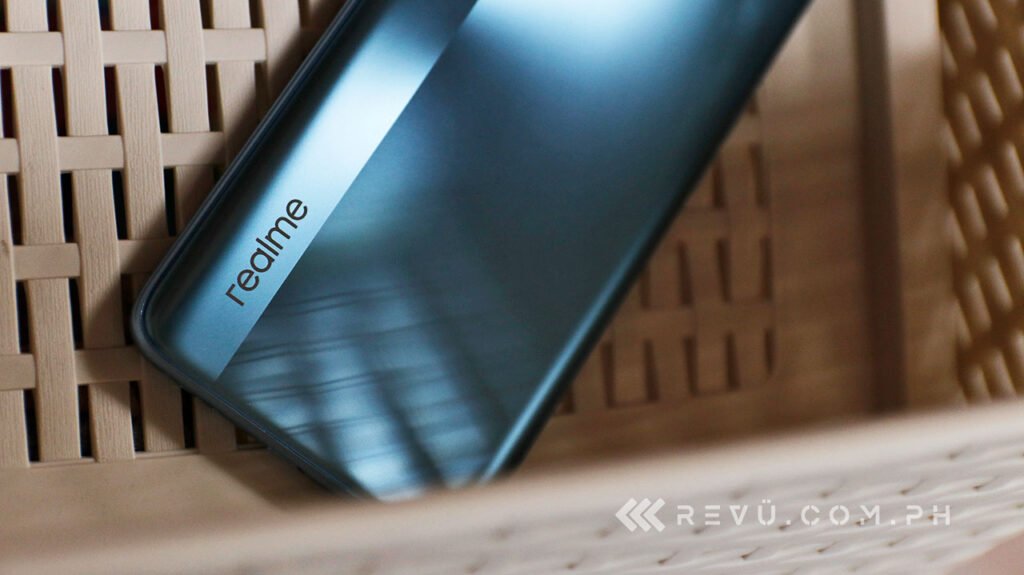
Realme takes a sleeker, cleaner approach with the Realme 7 Pro
The smooth matte finish is pleasant to touch, while a bit slippery at times. If you’re worried about smudges or accidentally dropping the phone, you can use the included silicone case to protect the handset. The Realme 7 Pro feels well-built and light. We can comfortably use it with one hand, but generally, it is a two-handed device.
Without using the case, the camera bump at the back protrudes significantly. Besides the camera module and the Realme logo, there’s no other interruption at the back of the handset. The right side has the power button, the left houses the volume rocker and a hybrid tray for two SIMs and a microSD card, and the bottom has a 3.5mm audio jack, USB-C port, and speaker grille.
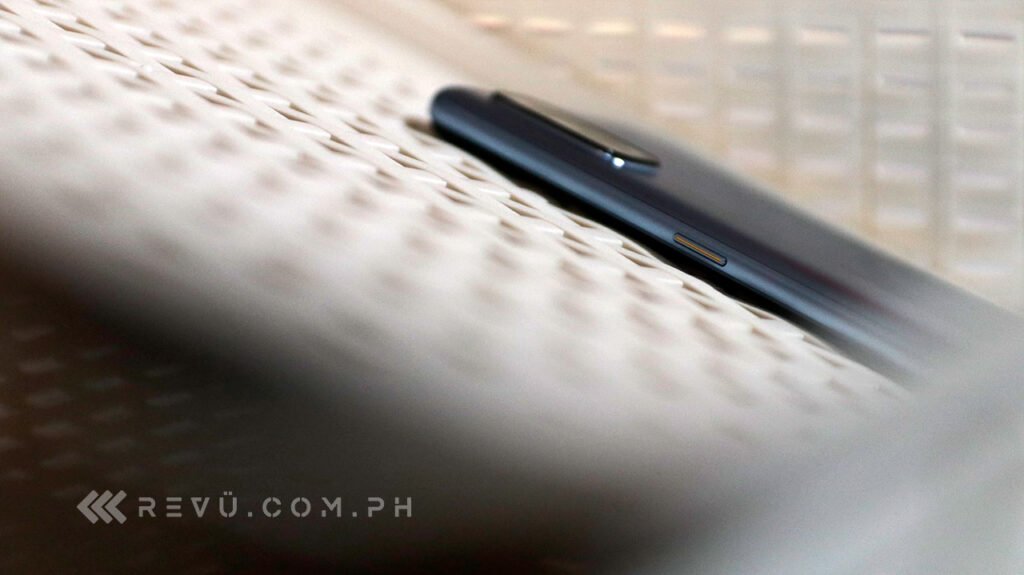
The right side has the yellow power button
The display is interrupted by a small cutout at the top-left corner for the selfie camera. There’s a thin strip for the earpiece/speaker at the top and a slightly thicker bezel at the bottom. Otherwise, the phone’s screen is flat and doesn’t curve off the edges.
We love that Realme offers a stereo speaker on the Realme 7 Pro, which means the audio comes out even louder. While you might hear some distortion and muddied notes, we like that there’s still sound coming from the earpiece when we’re playing most games. And since we sometimes rely on wired headphones, at least there’s an audio port here. But, like other Realme devices, you’ll need to use your own earphones/headphones, as the company doesn’t supply you with a pair.
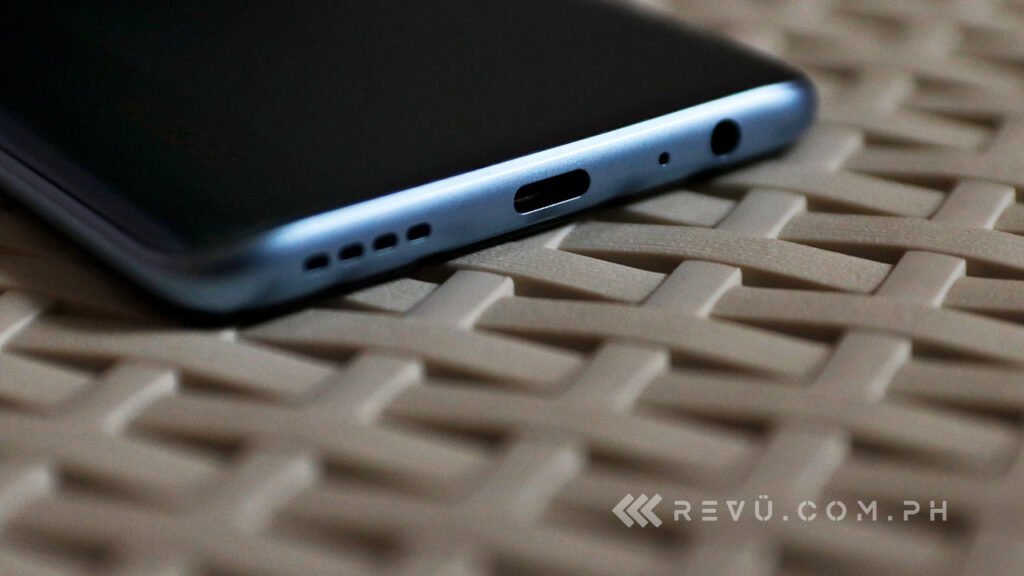
With a stereo speaker, the audio comes out even louder
As we mentioned in our hands-on review, the Realme 7 Pro offers the option to connect a Bluetooth headset while a pair of wired earphones are plugged into the handset, allowing for dual-audio output. You can enable this option under the Realme Lab tab in the Settings app.
Both the face unlock and the fingerprint sensor work relatively well, so we don’t have complaints there.
What’s in the box
- Realme 7 Pro
- Documentation
- Type-C to USB Cable
- USB Power Adapter
- SIM Ejector
- Protective Case
Screen
Let’s get it out of the way. The Realme 7 Pro doesn’t have a 90Hz refresh rate like the Realme 7 or the previous-generation Realme 6 Pro. So, if you’re looking for smoother scrolling or better gaming experience, we’re sorry to disappoint you.
Not that the 6.4-inch Super AMOLED display on the Realme 7 Pro is awful. It’s just Realme sticks with the more standard 60Hz refresh rate with 180Hz touch-sampling rate. The company has decided to improve the panel’s quality and throw in an in-display fingerprint sensor instead. If you come from a faster screen, you will notice the dip in smoothness here, even when you enable Smooth Scrolling in the Settings. It’s something you have to think about if you’re choosing between the two new Realme phones.
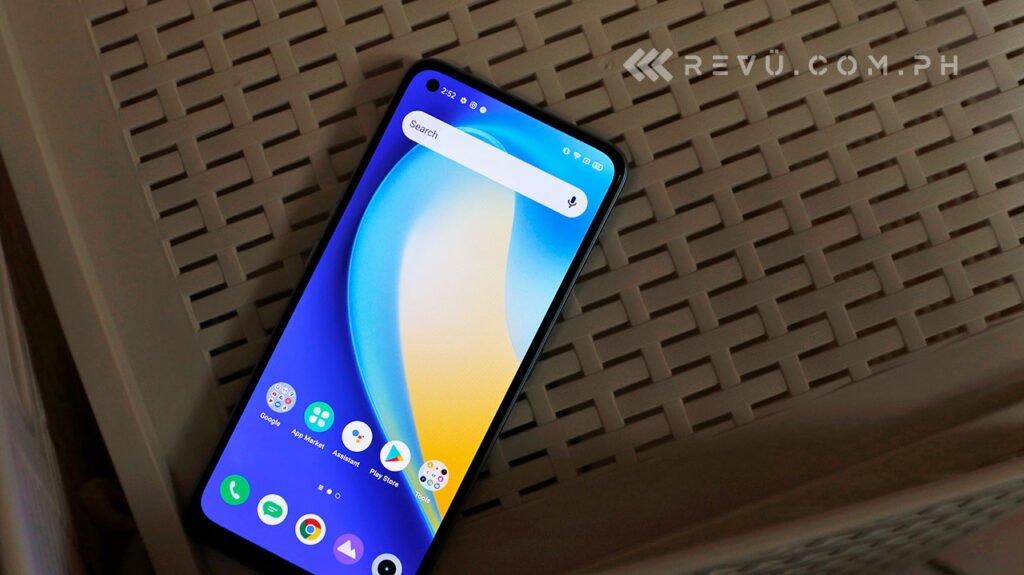
The Realme 7 Pro boasts a 6.4-inch Super AMOLED display
We’re not putting down how good the AMOLED screen is on the Realme 7 Pro because it is a great one. But we do wish its black levels could be deeper. With a 2,400 x 1,080 resolution, you get excellent color reproduction and viewing angles. Having an OLED panel allows for an always-on feature, too. It’s bright enough to be legible under direct sunlight. And it’s enjoyable to watch content on. If you have a Netflix account, you can enjoy full-HD content on this handset.
Realme boasts that the 7 series phones are the first to pass the TUV Rheinland Smartphone Reliability Verification tests, which are said to certify a comfortable viewing experience.
Camera
The Realme 7 Pro packs the same Sony IMX682 sensor available in the Realme 7 and Xiaomi’s POCO X3 NFC and Redmi K30 Ultra. What this sensor brings to this handset is better light-sensing capabilities, larger sensor and pixel size, and super-high pixels with support for Quad Bayer. So, you’re promised better pictures that are well-lit and properly exposed, even in low light.
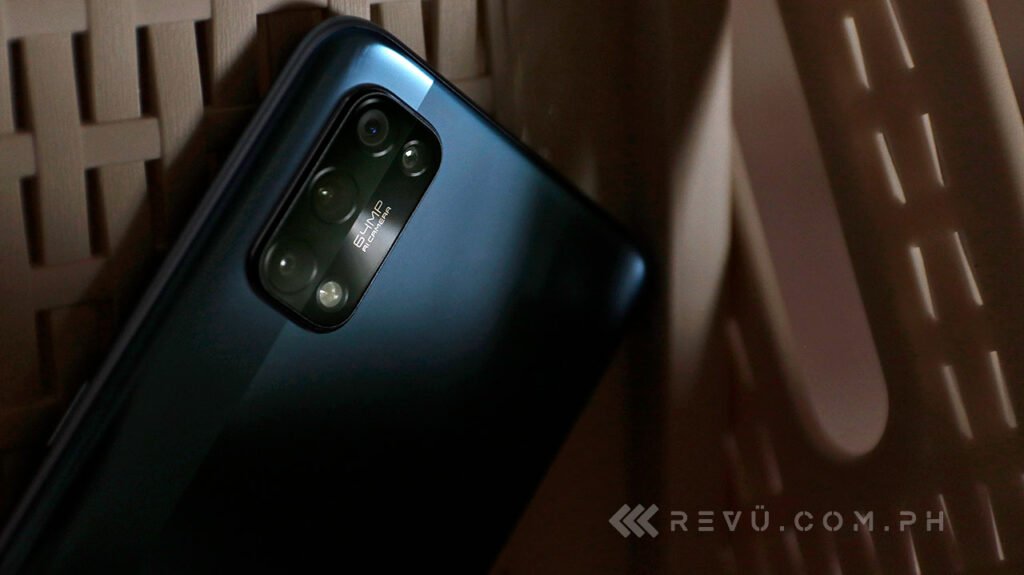
The Realme 7 Pro packs a 64-megapixel Sony IMX682 sensor
Besides that 64-megapixel Sony sensor with an f/1.8 lens, it also has an 8-megapixel secondary sensor with an f/2.3 ultra-wide-angle lens, a 2-megapixel monochrome sensor with an f/2.4 portrait lens, and a 2-megapixel sensor with an f/2.4 macro lens. Realme swapped out the telephoto lens on the Realme 6 Pro for the portrait sensor, which we wished it didn’t.
The primary sensor can take some pretty great photos in daylight, managing to preserve most details and keep the natural color of objects as accurately as it can. By default, the Realme 7 Pro produces 16-megapixel photos, but you can take full advantage of the main sensor and get 64-megapixel shots. Those will be useful for getting better-quality pictures, even if you crop into a photo, which will help as it doesn’t have a dedicated zoom lens.
Zooming-in series: From ultra-wide to 10x zoom
This handset offers up to 10x digital zoom, which produces images with a decent amount of detail. Sure, these pictures will drop in quality, but you can still make out what you’re trying to shoot.
Ultra-wide allows you to get more of your surroundings in one shot. But expect to lose the sharpness you’d get from the primary lens. The Realme 7 Pro’s ultra-wide sensor performs as well as we’ve seen on other smartphones. It works best in bright environments. We can say the same for the macro lens, which also needs a steady hand (or tripod) to produce quality photos.
[sciba leftsrc=”https://www.revu.com.ph/wp-content/uploads/2020/09/Realme-7-Pro-camera-sample-picture-Revu-Philippines_ultra-wide.jpg” leftlabel=”Ultra-wide” rightsrc=”https://www.revu.com.ph/wp-content/uploads/2020/09/Realme-7-Pro-camera-sample-picture-Revu-Philippines_1x.jpg” rightlabel=”Auto” mode=”horizontal” width=””]
Ultra-wide vs Auto
We’ve noticed that the Realme 7 Pro might be putting that mono sensor to work even without us using the dedicated Portrait mode. In some of our shots, we can see that the subject comes out crisp while the lights in the background and those we didn’t tap to focus on get blurred out. We like that you don’t even have to try that hard to get decent pictures. But if you prefer to tweak before you shoot, the Realme 7 Pro does have an Expert mode.
Macro-like auto? Here, we can see that the subjects come out crisp while the lights in the background and those we didn’t tap to focus on get blurred out
We always appreciate it when a smartphone comes with a dedicated Night mode. It takes out some of the work for us to get well-balanced photos in dark environments. Realme even brings this feature to an Ultra Night mode in video.
Night mode vs Auto mode
The company takes it up a notch further with Tripod and Starry modes. Set up your phone on a tripod and let it do all the work. Astrophotography fans will appreciate the latter. It always comes out better if you just don’t rely on holding the phone in your hands.
If you want a bit more control, there’s even a Pro Nightscape mode that allows you to tweak the settings.
As expected, image processing will take a bit of time when you use the phone in Night mode or when you try to capture full 64-megapixel shots. But otherwise, the Realme 7 Pro can speedily process the pictures you take, so you don’t miss out on what you want to shoot.
From our hands-on article more than a week ago: 1x, 2x, 5x, 1x, ultra-wide, Ultra Macro, Ultra Macro, 1x (effect of the lockdown, haha! — EIC)
And more pictures shot on the Realme 7 Pro
You can record video up to 4K at 30 frames per second with the Realme 7 Pro, which produces excellent quality videos as it does with photos. Even when we shoot while moving around, it somehow stabilizes our videos. It will also allow you to record clips using the ultra-wide sensor.
But if you want that gimbal-like effect, Realme adds its Ultra Steady and Ultra Steady Max modes in this smartphone. But be aware that in these modes, the Realme 7 Pro crops in. With Ultra Steady, it maxes out recording at 1080p at 60fps. While in Max mode, it records up to 30fps in the same resolution.
Playing around with the selfie camera
Realme gets rid of the secondary ultra-wide sensor for its front-facing option. Instead, it doubles the megapixel count of the selfie camera and gives you a 32-megapixel sensor with an f/2.5 lens. As always, you get great-quality selfies that help keep skin tone as natural as possible. AI Beauty mode is on by default, but you can choose to disable this feature. You get some good separation between the subject and background if you decide to take portrait shots with the selfie camera.
Performance
The Realme 7 Pro runs on a Qualcomm Snapdragon 720G paired with 8GB of RAM and 128GB of expandable storage. If you’re feeling a sense of déjà vu, it’s because this handset has the same chipset that powers the Realme 6 Pro. It is by no means an underpowered processor. It can handle multitasking and different kinds of games with ease. But a part of us still wishes Realme opted for a newer, more powerful processor for this model.
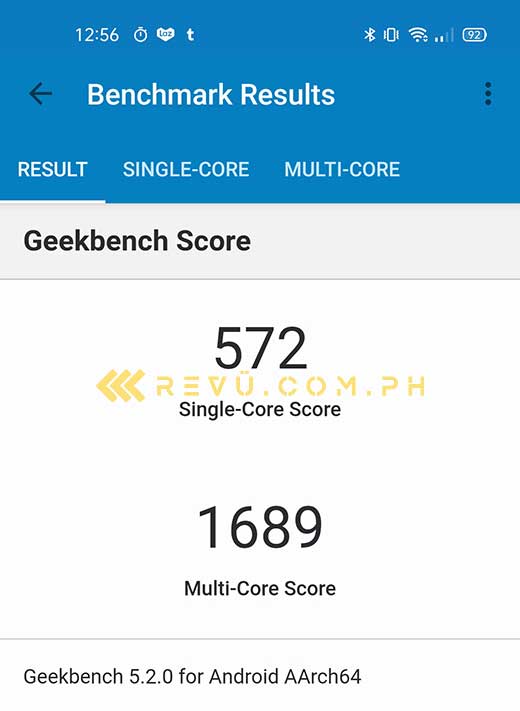
Realme 7 Pro’s benchmark scores in Geekbench. Somehow, we can’t run Antutu on our unit
It scores as we expected in our benchmark tests. The response is snappy, and crashes were hardly existent. As expected, the temperature rises when you multitask with different apps for an extended period. But the heat is nothing alarming or anything we can’t handle.
The Realme 7 Pro runs on Android 10-based Realme UI, which is smooth, fast, and a relatively clean interface. We still wish it would come with less preinstalled apps, though. We want to make the selection ourselves.
Battery
There are a lot of smartphones that have a 4,500mAh battery. But not a lot offer fast-charging as speedy as the one available on the Realme 7 Pro. It’s even more commendable since this 65-watt SuperDart Charge fast-charging tech is available on a handset costing less than P20,000 (less than $413).
The company claims the Realme 7 Pro can fully charge in just 34 minutes, or if you need a quick top-up, it can reach 13% in only three minutes. We put it to the test and got to 12% in three minutes, and a full charge from zero to 100% was achieved between 44 and 48 minutes. It’s not what Realme promised, but those are still impressive times.
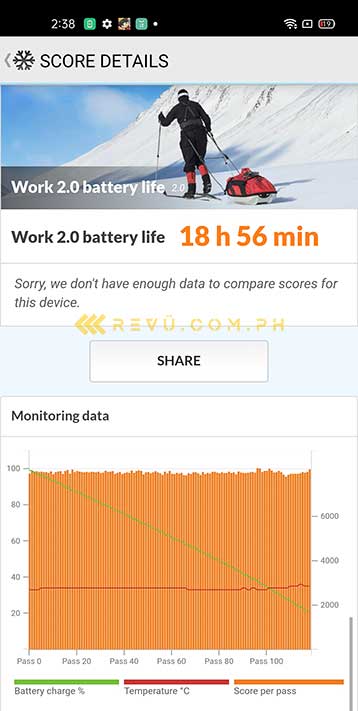
Result of our battery-rundown test
We achieved a respectable 18 hours and 56 minutes from our PCMark test. A full day or more is achievable on the Realme 7 Pro, even with heavy use that includes playing games, using LTE to stream music, browsing social media, taking photos, and the like. And even if you run it down quickly, you can make a meal and eat it, and the phone will most likely be fully charged after.
If you need a bigger battery, the Realme 7 has a 5,000mAh but with a slower, 30-watt Dart Charge charging tech.
Final thoughts
Realme delivers on its promise to offer extremely fast charging on the Realme 7 Pro, which is a proposition not often seen in its price range. So, if a long-lasting battery that quickly charges is essential for you, then you don’t need to look further than this handset.
Beyond that, the Realme 7 Pro is a solid performer. You get a wide range of camera hardware and software options to play with and a consistent overall performance wrapped in an attractive package, which can make its slightly higher price worth what you pay for it.
But suppose you’re looking for a smoother display with a faster processor. You might want to look elsewhere — especially since the Realme 7 Pro is pricier than the usual Realme handset, so you have more options available to you.
Realme 7 Pro specs
- 6.4-inch Super AMOLED display, 2,400 x 1,080 resolution, 60Hz refresh rate, 180Hz touch-sampling rate
- Octa-core 8nm Qualcomm Snapdragon 720G processor
- Adreno 618 GPU
- 6GB/8GB LPDDR4X RAM (do we mention the 6GB kahit wala siya dito?)
- 128GB UFS 2.1 storage
- Quad 64-megapixel, f/1.8 (main), 8-megapixel, f/2.3 (ultra-wide), 2-megapixel, f/2.4 (macro), 2-megapixel, f/2.4 (mono) rear cameras
- 32-megapixel, f/2.5 front camera
- Fingerprint reader (in-display)
- 4,500mAh battery with 65-watt USB-C charging
- 3.5mm headphone jack
- Stereo speakers
- Realme UI based on Android 10
- Color options: Mirror Silver, Mirror Blue
Share this Post

